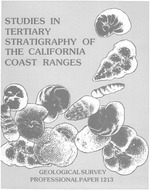Studies in Tertiary stratigraphy of the California Coast Ranges
Links
- Document: Report (pdf)
- NGMDB Index Pages:
- Download citation as: RIS | Dublin Core
Abstract
The correlation of rocks of Paleogene age in California with those in Europe has had a long and complex history that can only be highlighted here. Kleinpell (1938, p. 168-181), in his classic work defining Miocene benthic1 foraminiferal stages of California, attempted to correlate faunas of California with those of western Europe and elsewhere. He pointed out that rocks usually considered lower Miocene in California are probably correlative with those considered Oligocene in Europe. Schenck and Childs (1942) correlated the Vaqueros Sandstone of California with the middle and upper Oligocene of Europe and elsewhere, based on the stratigraphic occurrence of Lepidocyclina. Their correlation was discussed extensively by a number of paleontologists in the same report. Some favored a Miocene age based on similarities of the Vaqueros molluscan fauna with the Burdigalian faunas of Europe, and on the apparent Miocene age of vertebrates from beds below the Vaqueros. Others argued that some of the mollusks in the Vaqueros were similar to those considered Oligocene in Trinidad, and that the percentage of living mollusks in the Vaqueros Sandstone (1-2 percent) was most similar to faunas of Oligocene age. These differences in opinion proved to be irreconcilable in the attempt by the U.S. Committee on Stratigraphy to provide a standard correlation chart for marine Cenozoic formations of western North America (Weaver and others, 1944). Two standards had to be provided, one based largely on mollusks, echinoids, and corals, and the other on benthic foraminifers. This dual classification has persisted almost to the present.
The validity of some California Tertiary stages · based largely on benthic foraminifers .has been questioned in recent years. Pierce (1972) and Barron (1976) believed that the Delmontian Stage of Kleinpell (1938), for example, is coeval with the lower and middle part of his Mohnian Stage. Steineck and Gibson (1971), Gibson and Steineck (1972), Schmidt (1975), Bandy (1972) and Bukry, Brabb, and Vedder (1977) stated their belief that probably all of the California Paleocene and Eocene stages of Mallory (1959) are time-transgressive when compared to nannoplankton and planktonic foraminifer zonations. Hornaday and Philips (1972), on the other hand, challenged some of these opinions.
In order to further the study of the relation between California Paleogene stages based on benthic foraminifers with zonations based on planktic foraminifers and nannoplankton, nine paleontologists were invited to examine the faunas from several Coast Range sections measured by Brabb, Clark, and Throckmorton (1977). The results of their investigation were presented orally at a meeting of the International Subcommission on Paleogene Stratigraphy in Menlo Park, California on October 28, 1977. The talks were preceded by three days of field trips to the measured sections and were followed by a microscope workshop to debate the identification and age of the various faunas. The paleontologists were then encouraged to submit papers for this volume, and all have graciously complied.
Study Area
| Publication type | Report |
|---|---|
| Publication Subtype | USGS Numbered Series |
| Title | Studies in Tertiary stratigraphy of the California Coast Ranges |
| Series title | Professional Paper |
| Series number | 1213 |
| DOI | 10.3133/pp1213 |
| Year Published | 1983 |
| Language | English |
| Publisher | U.S. Geological Survey |
| Publisher location | Washington, D.C. |
| Contributing office(s) | Geology, Minerals, Energy, and Geophysics Science Center |
| Description | iv, 93 p. |
| Country | United States |
| State | California |
| Other Geospatial | Coast Ranges |


